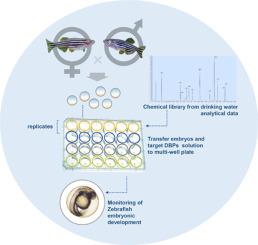Science of the Total Environment ( IF 9.8 ) Pub Date : 2020-06-25 , DOI: 10.1016/j.scitotenv.2020.140522 Raquel S Chaves 1 , Catarina S Guerreiro 2 , Vítor V Cardoso 3 , Maria J Benoliel 3 , Miguel M Santos 4

|
Disinfection By-products (DBPs) are formed during the chemical treatment of water for human consumption, by the reaction of raw water with chemical agents used in the different steps of the process. Disinfection is one of the most important steps, inactivating pathogens and preventing their regrowth during water distribution. However, it is also involved in DBPs formation due to the use of disinfectant agents, such as chlorine, which reacts with dissolved precursors, such as pharmaceuticals, toxins, pesticides, among others. Given their widespread occurrence, potential human health and (eco) toxicological impacts are of particular interest due to their potential carcinogenicity and various non-carcinogenic effects, such as endocrine disruption. In this study, the developmental toxicity of chemically- different unregulated DBPs was evaluated using zebrafish embryo bioassay. Embryos were exposed to different concentrations of the target DBPs and multiple endpoints, including, mortality, morphological abnormalities and locomotor behavior were assessed at specific developmental stages (24, 48, 72 and 96 hpf). The different families of DBPs tested included nitrosamines, aldehydes, alcohols and ketones. The results show that the effects were compound dependent, with EC10 values varying between 0.04 mg/L (2-ethyl-1-hexanal) to 9.2 mg/L (hexachloroacetone). Globally, several of the tested unregulated DBPs displayed higher toxicity when compared with the available data for some already regulated, such as trihalomethanes (THMs), which highlights the importance of screening the toxicity of still untested and poorly characterized DBPs.
中文翻译:

使用斑马鱼胚胎生物测定法对七种不受管制的饮用水消毒副产物(DBP)的毒理学评估。
消毒副产品(DBP)是在原水与人类消费用水的化学处理过程中通过原水与过程中不同步骤中使用的化学试剂的反应而形成的。消毒是最重要的步骤之一,可以使病原体失活并防止其在配水过程中再生。但是,由于使用消毒剂(例如氯)与溶解的前体(例如药物,毒素,农药等)反应,它也参与了DBP的形成。考虑到它们的广泛发生,由于其潜在的致癌性和各种非致癌作用,例如内分泌干扰,潜在的人类健康和(生态)毒理学影响特别令人关注。在这个研究中,使用斑马鱼胚胎生物测定法评估了化学性质不同的未调节DBP的发育毒性。胚胎暴露于不同浓度的目标DBP,并在特定发育阶段(24、48、72和96 hpf)评估了多个终点,包括死亡率,形态异常和运动行为。测试的DBP的不同家族包括亚硝胺,醛,醇和酮。结果表明,这些作用取决于化合物,EC10值在0.04 mg / L(2-乙基-1-己醛)至9.2 mg / L(六氯丙酮)之间变化。在全球范围内,与某些已经受管制的三卤甲烷(THM),


























 京公网安备 11010802027423号
京公网安备 11010802027423号